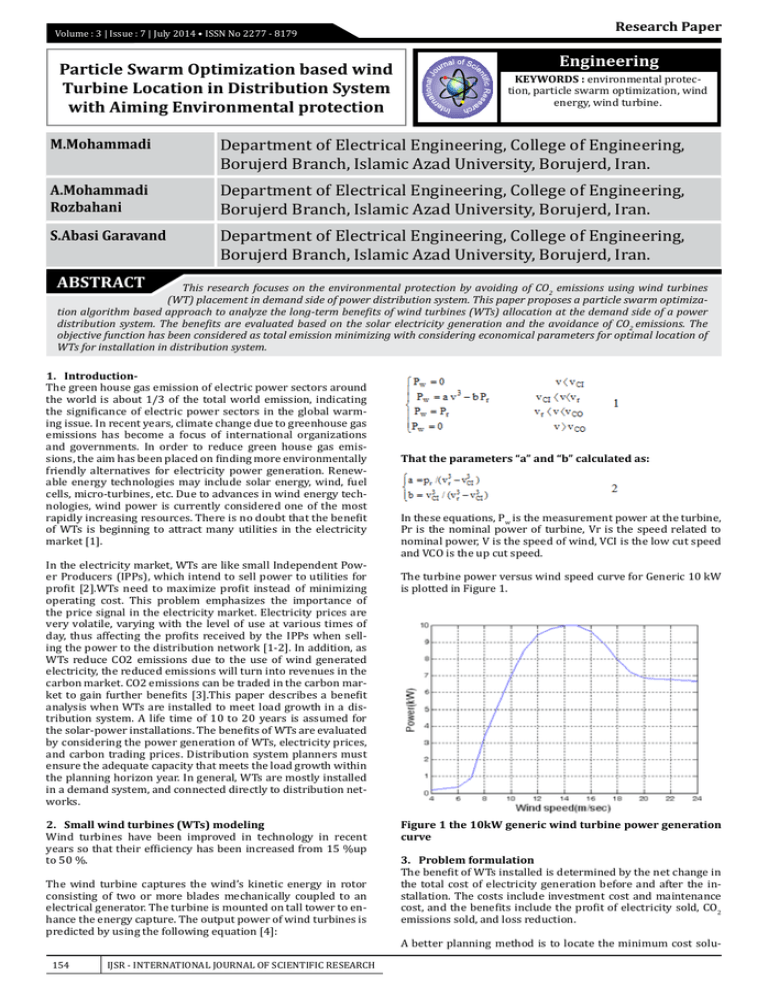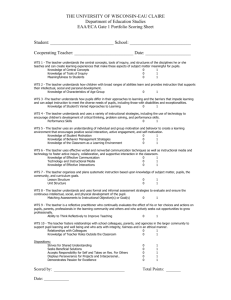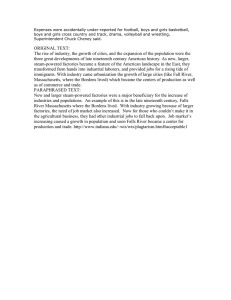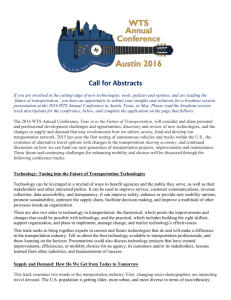Engineering Department of Electrical Engineering, College of
advertisement

Volume : 3 | Issue : 7 | July 2014 • ISSN No 2277 - 8179 Particle Swarm Optimization based wind Turbine Location in Distribution System with Aiming Environmental protection M.Mohammadi A.Mohammadi Rozbahani S.Abasi Garavand ABSTRACT Research Paper Engineering KEYWORDS : environmental protection, particle swarm optimization, wind energy, wind turbine. Department of Electrical Engineering, College of Engineering, Borujerd Branch, Islamic Azad University, Borujerd, Iran. Department of Electrical Engineering, College of Engineering, Borujerd Branch, Islamic Azad University, Borujerd, Iran. Department of Electrical Engineering, College of Engineering, Borujerd Branch, Islamic Azad University, Borujerd, Iran. This research focuses on the environmental protection by avoiding of CO2 emissions using wind turbines (WT) placement in demand side of power distribution system. This paper proposes a particle swarm optimization algorithm based approach to analyze the long-term benefits of wind turbines (WTs) allocation at the demand side of a power distribution system. The benefits are evaluated based on the solar electricity generation and the avoidance of CO2 emissions. The objective function has been considered as total emission minimizing with considering economical parameters for optimal location of WTs for installation in distribution system. 1.IntroductionThe green house gas emission of electric power sectors around the world is about 1/3 of the total world emission, indicating the significance of electric power sectors in the global warming issue. In recent years, climate change due to greenhouse gas emissions has become a focus of international organizations and governments. In order to reduce green house gas emissions, the aim has been placed on finding more environmentally friendly alternatives for electricity power generation. Renewable energy technologies may include solar energy, wind, fuel cells, micro-turbines, etc. Due to advances in wind energy technologies, wind power is currently considered one of the most rapidly increasing resources. There is no doubt that the benefit of WTs is beginning to attract many utilities in the electricity market [1]. In the electricity market, WTs are like small Independent Power Producers (IPPs), which intend to sell power to utilities for profit [2].WTs need to maximize profit instead of minimizing operating cost. This problem emphasizes the importance of the price signal in the electricity market. Electricity prices are very volatile, varying with the level of use at various times of day, thus affecting the profits received by the IPPs when selling the power to the distribution network [1-2]. In addition, as WTs reduce CO2 emissions due to the use of wind generated electricity, the reduced emissions will turn into revenues in the carbon market. CO2 emissions can be traded in the carbon market to gain further benefits [3].This paper describes a benefit analysis when WTs are installed to meet load growth in a distribution system. A life time of 10 to 20 years is assumed for the solar-power installations. The benefits of WTs are evaluated by considering the power generation of WTs, electricity prices, and carbon trading prices. Distribution system planners must ensure the adequate capacity that meets the load growth within the planning horizon year. In general, WTs are mostly installed in a demand system, and connected directly to distribution networks. 2. Small wind turbines (WTs) modeling Wind turbines have been improved in technology in recent years so that their efficiency has been increased from 15 %up to 50 %. The wind turbine captures the wind’s kinetic energy in rotor consisting of two or more blades mechanically coupled to an electrical generator. The turbine is mounted on tall tower to enhance the energy capture. The output power of wind turbines is predicted by using the following equation [4]: 154 IJSR - INTERNATIONAL JOURNAL OF SCIENTIFIC RESEARCH That the parameters “a” and “b” calculated as: In these equations, Pw is the measurement power at the turbine, Pr is the nominal power of turbine, Vr is the speed related to nominal power, V is the speed of wind, VCI is the low cut speed and VCO is the up cut speed. The turbine power versus wind speed curve for Generic 10 kW is plotted in Figure 1. Figure 1 the 10kW generic wind turbine power generation curve 3. Problem formulation The benefit of WTs installed is determined by the net change in the total cost of electricity generation before and after the installation. The costs include investment cost and maintenance cost, and the benefits include the profit of electricity sold, CO2 emissions sold, and loss reduction. A better planning method is to locate the minimum cost solu- Research Paper Volume : 3 | Issue : 7 | July 2014 • ISSN No 2277 - 8179 tion where the total benefits can be maximized. Therefore, costs and benefits of WT allocation in the network can be expressed as follows, with the cash flows presented below in Figure 2. Figure 2 Cash flows of the WT project 3.1 Investment cost The investment cost of WT units can b formulated as the following equation: 4. Particle Swarm Optimization In a PSO system, Birds’ (particles) flocking optimizes a certain objective function. Each particle knows its current optimal position (pbest), which is an analogy of personal experiences of each particle. Each particle also knows the current global optimal position (gbest) among all particles in the population. Through specific equations, each particle adjusts its position and determines the search direction according to its search memory and those of others. Using the PSO, the velocity can be represented under Eq. (14) in the PSO algorithm. Using Eq. (13), a certain velocity can be calculated as the position of individuals gradually moves closer to pbest and gbest. The current position can be modified by: 3.3 The Profit of CO2 Sold The main profit of WT installation is the profit of CO2 sold which encourages engineering planers to employ the wind turbines in distribution systems. The profit of CO2 sold, 5. Simulation and Results The proposed algorithm was applied to solve the 33-bus distribution system problem, as shown in Figure 3 [7].The total real and reactive power demand of the 33 bus system were 1470 kW and 1012 KVAR, respectively. The maximal power generation of WTs is set to 300kW. The PSO parameter used in this paper was listed in Table 1. The power output for each WT ranged from 200kW to 300kW, while all network bus voltage magnitudes remained within 0.95-1.05/ unit. The power factor for each WT was 0.75. The load growth rate was 3% in the distribution system, and the horizon years were set at 20, 30 and 40 years. Table 2 shows the summary of the simulation results. Table 1 PSO parameters Indices Parameter value C1,C2 5 Num. of particles (d) No. of iteration 500 500 6 q dmax − 0.5q d Due to the load growth, the number of WTs installed was 3, 5 and 9 at 20, 30 and 40 horizon years in order to meet the load IJSR - INTERNATIONAL JOURNAL OF SCIENTIFIC RESEARCH 155 Research Paper Volume : 3 | Issue : 7 | July 2014 • ISSN No 2277 - 8179 growth and operational constraints. The total power output of WTs was 408.45 kW, 705.30 kW and 1102.42 kW at the different horizon years. The results suggested that the WTs installed significantly improved on the system losses. Because the executed characteristics of PSO might converge at different solutions for each test, the problem was solved 50 times by the proposed method. The best and worst system losses were found from the 50 trial tests. The best percentage of loss reduction ranged from 12.24% to 34.20% at the various horizon years. Figure 4 shows the voltage profiles before and after the WTs were installed at the 20-th horizon year. Figure 5 The convergent characteristics of the proposed method. Figure 3 Single Line Diagram of the 33-Bus Radial Distribution System Table 2 shows the summary of the simulation results. Horizon year Total real load demand (kW) Total reactive load demand (KVAR) The total power output of WTs(kW) The average percentage of loss reduction (%) The number of WTs installed The location of WT(no. of bus) 20 30 40 1210 1400 1650 1705 1980 408.45 705.30 25.46 3 30.80 5 2290 In Case-1, the carbon price varied from between 0-2000 NT$/ ton. In case 2 the power generation varied between 200-300 kW/unit. A lifetime of 20 years was assumed for the WTs installed. Figure 6 shows the benefits analysis of WTs installed in Case 1. The largest positive contribution to the WTs’ benefit was from the reduction in CO2 charges. 1102.42 35.20 9 7,11,19 7,15,19,23,28 3,5,7,14,18 23,25, 29,32 Figure 6 The benefits of WTs installed in Case-2 versus carbon price at the various horizon year The investment in WTs arrived at economical equilibrium when the carbon prices were sold at 800 NT$/ton in this case. When the carbon price was high, the benefits of the WT investment would increase. Figure 4 The voltage profiles before and after the WTs installation Figure 7 shows the benefits of WTs installed in Case-2. As seen, when the power generation for each WT was about 140kW, the investment in WTs could arrive at economical equilibrium. When the power generation of WTs increased, the benefits of the WT investment were also higher. The benefits sensitivity analysis of WTs contained two scenarios which varied with the electricity price, carbon price, and power generation after the WTs were installed. Table 3 shows the conditions of two scenarios in this study. Table 3 The conditions of three scenarios in this study. Carbon price (NT$/ton) Power generation (kW/unit) Case 1 0-2000 Case 2 800 140 200-300 As shown in Figure 4, the voltage profile was clearly improved after the WTs were installed, almost satisfying the voltage limits along the feeder. Figure 5 shows the convergent characteristics of the proposed method at the 20-thhorizon year. The convergent generation was about the 300-th generation 156 IJSR - INTERNATIONAL JOURNAL OF SCIENTIFIC RESEARCH Figure 7 The benefits of WTs installed in Case-3 versus generation output at the various horizon year Research Paper 6.Conclusion This study successfully solved the photovoltaic allocation in distribution systems by aim of CO2 emission reduction using PSO. Volume : 3 | Issue : 7 | July 2014 • ISSN No 2277 - 8179 By considering electricity price and carbon price, the economical benefits of the installation of WTs were evaluated in three different scenarios. This study found that electricity price or carbon price is a key parameter in the development of WTs. Simulation results also showed that optimal incorporating the WTs in the distribution system can reduce system losses, as well as improve the voltage profiles. In addition, it is found that as WTs reduce CO2 emissions due to the use of solar generated electricity, the reduced emissions will turn into revenues in the carbon market. REFERENCE [1] D.B. Nelson, M.H. Nehrir, C. Wang, 2006, Unit sizing and cost analysis of stand-alone hybrid wind/PV/fuel cell power generation systems Renewable Energy 31 (2006) 1641–1656. | [2] Orhan Ekren a, Banu Y. Ekren,2010, Size optimization of a PV/wind hybrid energy conversion systemwith battery storage using simulated annealing, Applied Energy 87 (2010) 592–598. | [3] Belgin Emre Türkay, Ali Yasin Telli,2011, Economic analysis of standalone and grid connected hybrid energy systems, Renewable Energy 36 (2011) ,1931-1943. | [4] Rodolfo Dufo-Lopez, JoseL. Bernal-Agustı n, 2008, Multi-objective design of PV–wind– diesel– hydrogen– battery systems, Renewable Energy 33 (2008) 2559– 2572. | [5] Aris Kornelakis, 2010, Multi-objective Particle Swarm Optimization for the optimal design of photovoltaic grid-connected systems, Solar Energy 84 (2010) 2022–2033. | [6] Chun-Hua Li, Xin-Jian Zhu, Guang-Yi Cao, Sheng Sui, Ming-Ruo Hu, Dynamic modeling and sizing optimization of stand-alone photovoltaic power systems using hybrid energy storage technology,2009, Renewable Energy 34 (2009) 815–826. | [7] J.K. Kaldellis, D. Zafirakis, E.L. Kaldelli, K. Kavadias, 2009, Cost benefit analysis of a photovoltaic-energy storage electrification solution, Renewable Energy 34 (2009) 1299–1311. | IJSR - INTERNATIONAL JOURNAL OF SCIENTIFIC RESEARCH 157





